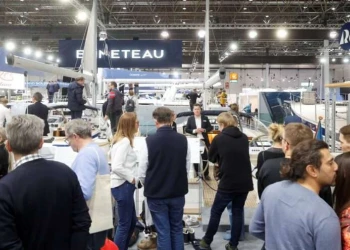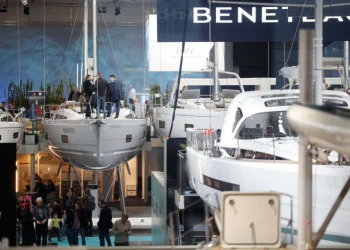
Sailing yachts at boot 2024, safety and comfort for enjoying life on board
Sailing yachts at boot 2024, safety and comfort for enjoying life on board
boot Düsseldorf 2024 will be presenting the whole world of yachting in Halls 15 and 16 – from small, racy dinghies and sporty sailing yachts under 30 feet to large yachts for extended cruises. New launches are dominated by yachts with plenty of floor space above and below deck, for single and short-handed sailing.
The small keel yachts under 30 feet LOA thrill especially with their dinghy-type, racy sailing abilities and the simple, unadulterated joy derived from sailing really close to the water. The borders between sporty standard boats and fast daysailers, which can be used for both challenges and full-day sails or little weekend trips, are blurred, here. A case in point is the Saffier SE 24 Lite, which offers the elegant look typical of this Dutch shipyard and high potential speeds both steering close to the wind and sailing broad reach. Like many other new developments in various sizes, this small yacht also features an electric pod drive complete with solar panel system integrated in the foredeck.
The absolute eye-catcher at boot 2024 will be the trade fair’s biggest sailing yacht: a 69-foot luxury touring yacht by Hallberg-Rassy, celebrating its world premiere at the world’s largest in-door boat show. This yacht fuses all the ingredients of modern yacht building with the accustomed high quality of this tradition-rich Swedish shipyard, convenience and with outstanding sailing abilities for any type of weather and cruising region. Designed as the ideal yacht for ocean cruises, she boasts plenty of storage space and sophisticated energy and water supply systems, making her independent of onshore supply stations – features also found in the smaller yachts described below.
Cooking as a community event
With larger, 35+ foot yachts there is a growing trend towards social cooking, preferably also below deck. The pantries below deck are often L-shaped, integrated into the salon or extend over the entire side of the ship. Above deck, at least one outdoor barbecue with “plancha” cooker and a little sink has become standard, often complemented with an outdoor fridge and/or cool box to store drinks.
More space and comfort
What was celebrated as an innovation for the sporty Mini and Class 40 yachts some years ago, now continues with the trend towards voluminous hulls and the ensuing, protruding bow shapes. Below deck, this gives rise to large, spacious cabins in the forecastle often used as owners’ staterooms with free-standing beds on three sides. This “hotel-bed” look – combined with sophisticated wardrobe solutions and small storage compartments, gives these cabins an elegant luxury look & feel. Like in the stern: thanks to the dual helm and, hence, two rudders it is possible to go for a wider and, hence, more voluminous stern. This results in two spacious cabins or one berth and a large storage room on the opposite side.
This becomes particularly evident with Bavaria Yachts’ c46 to be premiered indoors at boot Düsseldorf 2024. The extensive chines in the stern and striking V-shaped hull give rise to a spacious interior below deck.
Lots of daylight and brightness
Not only Bénéteau points the way with its Oceanis series: windows integrated into the hull provide plenty of natural light in the cabins and nearly every berth offers vistas of the sea, the port or also the romantic bay you are anchoring in. Additional glazed hatches in the coachroof allow additional daylight into the interior flooding it with bright sunlight. Many hatches can be opened ensuring good ventilation of the ship. The installation of numerous, energy-saving LED luminaires on the ceiling and as reading lights in the berth provide even more brightness. Many yachts designed for sun-drenched destinations in the Med or Caribbean are additionally equipped with air-conditioning. The required energy is increasingly generated by solar panels.
Luxury and comfort below deck
Generously proportioned berths, wide beds with thick mattrasses, several bathrooms with toilet and shower as well as seating and lounging galore make for maximum comfort on board. This also includes headroom below deck and a host of clever fittings that ensure a TV and sound experience like at home. Considered increasingly important here is an accomplished mix of community areas such as the cockpit and salon and the spacious privacy area. Cabins are clearly separated from each other and often equipped with en-suite heads. On bigger yachts such as the Dufour 44 even the toilet and shower are separate.
Everything on the same level
Multi-hull lovers, in particular, appreciate living on one “floor” only – accessing salon and pantry from the cockpit through sliding doors without any steps. This generous feeling of space without a companionway is the hallmark of Moody’s deckhouse yachts. With the Hanse Yachts from the Greifswalder shipyard cockpit, salon, navigation and pantry are all located flush on the same level, the helms are installed on deck. This stepless, seamless transition from one living area to the next promotes socialising on board, permits skippers to always be near their crew and guests allowing them to enjoy the hours at sea together.
Multifunctional possibilities
Plenty of room for hours spent together with your large family crew or friends is one of the essential features of successful cruising yachts. Cockpit tables, often retractable, can be converted into additional lounging area. Below deck, expansive living areas await yachtspeople often with horseshoe or L-shaped sofas and flexible, free-standing stools. A special treat comes care of the new Dufour 44 with its hexagonal dining table conveniently seating up to eight guests thanks to additional stools. Also retractable, this salon table can be converted into sleeping space for two at the flick of a wrist.
Highly individual and flexible
Other essential features of modern yachts are flexibility and many different configuration options – all in line with the owners’ differing demands and ideas. With many yachts, not only the colour of the interior and upholstery but also the number of cabins can be selected individually; it as also possible to choose between various pantry options. Customers can either opt for a long kitchenette with large tabletops and plenty of storage room along the side or position the pantry against the main bulkhead in the bow. Likewise, owners can also decide on their yachts’ deck layouts and opt for cruiser or racer versions.
Storage room galore for many toys
Next to space on and below deck and in cabins, many yachtsmen and women also attach more and more importance to storage space and, hence, room for their toys. Not only cycles are transported on board – dinghies with outboard motors are often as common as SUP boards, kite or wingfoiling equipment. Depending on the yacht’s size, these can be stored either in roomy bench boxes or a separate room instead of an aft berth.
The new XC 47 from the Danish shipyard X-Yachts, for instance, offers particularly generous additional storage space. In addition to an enormously deep storage for unused wardrobe, the yacht also boasts a very large bench box aft as well as numerous cabinets and drawers in all cabins and heads. Even the room underneath the aft berths has been used for extra storage with drawers.
Easy sailing
Sun beds on deck for spending relaxed hours in the sun can be had on the foredeck, on deck and even in the cockpit. To this end, the cockpit tables of many yachts can be lowered to create an expansive lounging area. Drop-down swim platforms allow direct access to the water and are often also fitted with a shower allowing you to shower off with fresh water right after a dip in the sea.
Ocean protection
With environmental protection in mind, boatbuilders increasingly forego anti-foiling and protect the sensitive ship hulls with a protective film designed to prevent marine growth instead. Black-water tanks have also become a standard feature these days, and for water preparation and/or seawater desalination many yachts have electrical watermakers which also provide fresh drinking water from the sea during longer cruises. This makes yachts independent of onshore supply stations and grants a wider range for planning cruises.
Electrical drives
In the dinghy and tender segment, electrical drives have been a welcome alternative to conventional, fuel-propelled outboard engines for years. More and more new series-built yachts now also use electrical or hybrid inboard motors. In addition to high-performance lithium-ion batteries, more and more solar panels are attached to biminis and deckhouses serving as another alternative energy source.
Digitalisation and Apps
With digital nautical charts and displays all required information can be read both on and below deck. Speed, direction of wind, fuel gauge, consumption, etc. This means the space formerly taken up by the navigator’s chart table has become substantially smaller. Often, the chart table is discreetly integrated into the lounging area of the salon. New yachts are increasingly offered with their own App, which allows owners to control the complete consumption levels on board, but also boat movements when mooring, and warns them of possible deep discharge of batteries, theft or burglary. The Bénéteau Group, for example, has developed an App called SeaNapp that allows for an almost complete monitoring of the yacht even far away from the marina. In addition, there is a wide variety of Apps based on other sailors’ recommendations sharing information about harbours, anchoring options and possible changes in the planned cruising regions with the community.
Easy sailing and fast cruising
“Easy Sailing” is the buzzword for modern yachts built for single-handed sailing with halyards, rope trims consistently led to the aft cockpit. This way, the crew sailing along – family, friends, guests – have almost the complete cockpit available to themselves for relaxing.
“Fast Cruising”: this means high stability, long water lines and optimal performance. Modern yachts achieve high potential speeds even with short-handed sailing, can also easily be sailed by one skipper and convince us with good sailing abilities. While main sail and genoa make for speed when sailing into the wind or at degrees to the wind, gennakers are the choice for relaxed running downwind, and a Code0 rounds off the wardrobe. Like for interiors, future owners often also have the opportunity to influence their future boat’s set of sails, opting for an overlapping genoa with adjustable hole positions or a smaller self-tacking jib. The good sailing abilities of modern cruising yachts are ensured especially by their chines, extending the water lines.
Next to electrical anchor winches, cruising yachts increasingly come with electrical winches for the genoa sheets – facilitating the strenuous winching after tacking and jibbing. Next to roll reefing genoas, there are more and more main sails than can be set and hoisted electrically. Combined with an autopilot to also control sailing manoeuvres, this also allows convenient single-handed sailing of 45+ foot yachts. Mooring in harbours is facilitated by bow thrusters.
Plenty of privacy
For new yacht design in the 50+ feet segment, there are also exciting developments such as the installation of two companionways. With this move, both the 50 CS and the Hallberg-Rassy 50 or Oyster 495 smartly separate the area for the owner couple from the guests’ access to their cabins. This provides for even more privacy and seclusion. Just as important as the community feeling on deck, in the pantry while cooking together or in the salon, is the possibility to withdraw to secluded, separate cabins.
Many possible versions and visualisation
In addition to the possibility boot Düsseldorf offers its visitors to take a closer look at many single and multi-halls and even develop a feel for what it would be like to take to sea on board this yacht, many shipyards allow interested parties to see their own colour concept for interior design by way of animations and thereby experience the look & feel of their own dream yachts.
The world’s largest yacht and watersports trade fair
Registering just under 237,000 visitors from over 60 countries and more than 1,500 exhibitors from 68 nations occupying 220,000 square metres in Halls 1 to 17, boot Düsseldorf from 20 to 28 January 2024 will be the world’s biggest yacht and watersports trade fair. Both yachtspeople and powerboaters will find a wide variety of boats, dinghies, super boats and luxury yachts. The popular sports diving, surfing, kitesurfing, SUP, skim boarding or canoeing will be presented in all their facets and with the corresponding equipment at boot. Attractive stage activities featuring the stars of the scene, current trends and a high-calibre mix of workshops and join-in activities for both amateur sportspeople and experts, all make this trade fair unique the world over. But marine protection and innovative, sustainable technologies will also be in focus at boot 2024. In cooperation with the European Boating Industry (EBI) the blue innovation dock will provide a unique dialogue format with political, business, technological and media expertise in Hall 10. Furthermore, two beacons for the protection of our oceans will be “on board” again. The prestigious “ocean tribute” Award presented in partnership with the Prince Albert II of Monaco Foundation and the German Ocean Foundation as well as the “love your ocean” campaign with its stand in Hall 11.





